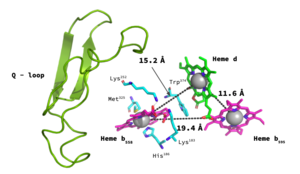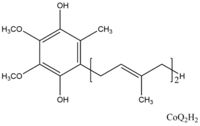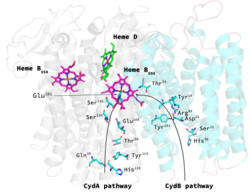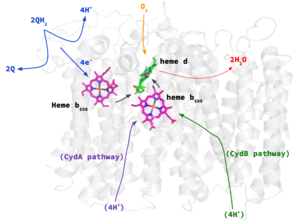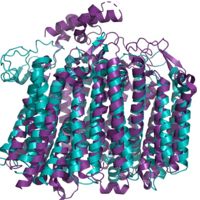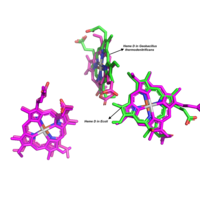Sandbox Reserved 1600
From Proteopedia
Contents |
bd oxidase; Geobacillus thermodenitrificans
Introduction
is an integral membrane protein that catalyzes the reduction of oxygen to water using quinol as the reducing substrate.[1] The full reaction is O₂ + 4H+ + 4e- → 2H₂O. The reaction is electrogenic but it is not coupled to a proton pump. Instead, bd oxidase utilizes internal water molecules to provide the four protons needed for the reduction reaction and an external ubiquinone molecule for the four electrons needed.[2] bd oxidase plays a key role in protecting the organism from high oxidative stress. In a gram-negative bacteria heterotrophs like Geobacillus thermodenitrificans, bd oxidase prevents free radicals in the intracellular space. Other organisms, like humans, have mechanisms that do the same thing but are more intricate due to the organism’s higher levels of complexity.
There are two main types of respiratory cytochrome oxidases: the heme/copper oxidases and the heme-only cytochrome bd quinol oxidase, which is what bd oxidase falls under.[3] Heme-only cytochrome bd quinol oxidases are associated with microaerobic dioxygen respiration, and they have a high affinity for oxygen.
The G. thermodenitrificans is a facultative aerobic thermophilic bacterium that utilizes the bd oxidase mechanism. The oxygen enters the enzyme through the selective that funnels the extracellular oxygen to in the active site. The electrons for the reaction are provided by a ubiquinone molecule bound to the . The protons for the reaction are provided by one of two , either the or . Both of the proton pathways utilize the intracellular water molecules for the proton source, and shuttle them to .
| |||||||||||
Biological Importance of O₂ reduction
Oxygen toxicity is a fatal problem among all organisms, but can easily occur in prokaryotes due to their low oxygen tolerance. In prokaryotes, the cytochrome bd oxygen reductases function to quickly reduce the concentration of O₂ into H₂O to protect the cell from detrimental effects. Without proper functioning of these enzymes, or if O₂ concentrations are too high, the concentrations of the intermediates formed from the reduction reaction will increase and can be detrimental. As a result, cytochrome bd oxidases facilitate growth in both pathogenic and commensal bacteria causing them to be a vital enzyme for cellular growth and division. Their importance in anaerobic prokaryotes makes bd oxidases useful targets for drug development to combat bacterial infection.[6]
References
- ↑ Giuffre A, Borisov VB, Arese M, Sarti P, Forte E. Cytochrome bd oxidase and bacterial tolerance to oxidative and nitrosative stress. Biochim Biophys Acta. 2014 Jul;1837(7):1178-87. doi:, 10.1016/j.bbabio.2014.01.016. Epub 2014 Jan 31. PMID:24486503 doi:http://dx.doi.org/10.1016/j.bbabio.2014.01.016
- ↑ 2.0 2.1 2.2 2.3 2.4 2.5 2.6 2.7 2.8 2.9 Safarian S, Hahn A, Mills DJ, Radloff M, Eisinger ML, Nikolaev A, Meier-Credo J, Melin F, Miyoshi H, Gennis RB, Sakamoto J, Langer JD, Hellwig P, Kuhlbrandt W, Michel H. Active site rearrangement and structural divergence in prokaryotic respiratory oxidases. Science. 2019 Oct 4;366(6461):100-104. doi: 10.1126/science.aay0967. PMID:31604309 doi:http://dx.doi.org/10.1126/science.aay0967
- ↑ Das A, Silaghi-Dumitrescu R, Ljungdahl LG, Kurtz DM Jr. Cytochrome bd oxidase, oxidative stress, and dioxygen tolerance of the strictly anaerobic bacterium Moorella thermoacetica. J Bacteriol. 2005 Mar;187(6):2020-9. doi: 10.1128/JB.187.6.2020-2029.2005. PMID:15743950 doi:http://dx.doi.org/10.1128/JB.187.6.2020-2029.2005
- ↑ Safarian S, Rajendran C, Muller H, Preu J, Langer JD, Ovchinnikov S, Hirose T, Kusumoto T, Sakamoto J, Michel H. Structure of a bd oxidase indicates similar mechanisms for membrane-integrated oxygen reductases. Science. 2016 Apr 29;352(6285):583-6. doi: 10.1126/science.aaf2477. PMID:27126043 doi:http://dx.doi.org/10.1126/science.aaf2477
- ↑ Thesseling A, Rasmussen T, Burschel S, Wohlwend D, Kagi J, Muller R, Bottcher B, Friedrich T. Homologous bd oxidases share the same architecture but differ in mechanism. Nat Commun. 2019 Nov 13;10(1):5138. doi: 10.1038/s41467-019-13122-4. PMID:31723136 doi:http://dx.doi.org/10.1038/s41467-019-13122-4
- ↑ Borisov VB, Gennis RB, Hemp J, Verkhovsky MI. The cytochrome bd respiratory oxygen reductases. Biochim Biophys Acta. 2011 Nov;1807(11):1398-413. doi:, 10.1016/j.bbabio.2011.06.016. Epub 2011 Jul 1. PMID:21756872 doi:http://dx.doi.org/10.1016/j.bbabio.2011.06.016
Proteopedia Resources
- Structure of bd oxidase from Geobacillus thermodenitrificans
- Cryo-EM structure of the E. coli cytochrome bd-I oxidase
Student Contributors
Emma H Harris
Carson E Middlebrook
